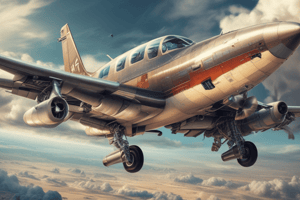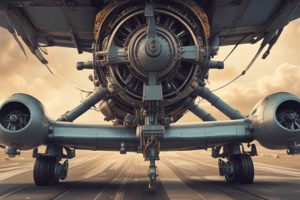Podcast
Questions and Answers
What is the primary advantage of a conventional landing gear configuration?
What is the primary advantage of a conventional landing gear configuration?
- Easy to control during takeoff and landing
- Level cabin area for passengers
- Reduced drag in the air (correct)
- Increased stability on the ground
What is a characteristic of an aircraft with a tricycle landing gear?
What is a characteristic of an aircraft with a tricycle landing gear?
- The aircraft has a tail wheel
- The aircraft has only two main wheel assemblies
- The aircraft fuselage is tilted during takeoff and landing
- The aircraft fuselage is in a level attitude on the ground (correct)
What is a disadvantage of a conventional landing gear configuration?
What is a disadvantage of a conventional landing gear configuration?
- Increased stability on the ground
- Easy to control during takeoff and landing
- Less stable on the ground (correct)
- Reduced drag in the air
What is an advantage of a tricycle landing gear configuration?
What is an advantage of a tricycle landing gear configuration?
What is a characteristic of an aircraft with a conventional landing gear?
What is a characteristic of an aircraft with a conventional landing gear?
What is the primary purpose of a landing gear system?
What is the primary purpose of a landing gear system?
What is the primary function of the compressed air in the chamber of an air-oleo shock-absorbing landing gear?
What is the primary function of the compressed air in the chamber of an air-oleo shock-absorbing landing gear?
What is the main advantage of retractable landing gear?
What is the main advantage of retractable landing gear?
What is the purpose of fairing on fixed gear?
What is the purpose of fairing on fixed gear?
What is the primary importance of retractable landing gear?
What is the primary importance of retractable landing gear?
What is the purpose of panels attached to the retractable landing gear of a Boeing 737?
What is the purpose of panels attached to the retractable landing gear of a Boeing 737?
What is the purpose of wheel pants on fixed gear?
What is the purpose of wheel pants on fixed gear?
What type of power is used to operate retractable landing gear?
What type of power is used to operate retractable landing gear?
What is the purpose of the torque links in a retractable landing gear system?
What is the purpose of the torque links in a retractable landing gear system?
What is the primary function of the drag link?
What is the primary function of the drag link?
Which component is often referred to as a scissors assembly?
Which component is often referred to as a scissors assembly?
What is the purpose of the side brace link?
What is the purpose of the side brace link?
What is the name of the component that contains the shock-absorbing mechanism?
What is the name of the component that contains the shock-absorbing mechanism?
What is the purpose of the overcenter link?
What is the purpose of the overcenter link?
What is the name of the component that is attached to the airframe?
What is the name of the component that is attached to the airframe?
What is the name of the component that can tilt fore and aft?
What is the name of the component that can tilt fore and aft?
What is the name of the component that holds wheels and axle in a correctly aligned position?
What is the name of the component that holds wheels and axle in a correctly aligned position?
What is unique about Type I tires?
What is unique about Type I tires?
What is a characteristic of Type III tires?
What is a characteristic of Type III tires?
What is common among Types I, III, VII, and VIII tires?
What is common among Types I, III, VII, and VIII tires?
What is unique about Type VII tires?
What is unique about Type VII tires?
What is a feature of Type VIII tires?
What is a feature of Type VIII tires?
How are Type I tires designated?
How are Type I tires designated?
What is the primary function of main landing gear?
What is the primary function of main landing gear?
What type of landing gear is typically used in helicopters and sailplanes?
What type of landing gear is typically used in helicopters and sailplanes?
What is the purpose of the shock cord in shock-cord landing gear?
What is the purpose of the shock cord in shock-cord landing gear?
What is the function of the oleo strut in spring-oleo struts?
What is the function of the oleo strut in spring-oleo struts?
What is the purpose of the spring in spring-type gear?
What is the purpose of the spring in spring-type gear?
What is the main difference between main landing gear and auxiliary landing gear?
What is the main difference between main landing gear and auxiliary landing gear?
What is the purpose of the brakes in main landing gear?
What is the purpose of the brakes in main landing gear?
What is the purpose of the cowling and fairing in main landing gear?
What is the purpose of the cowling and fairing in main landing gear?
Flashcards are hidden until you start studying
Study Notes
Landing Gear Systems
- Landing gear designs vary from fixed arrangements to complex retractable systems.
Landing Gear Configurations
- Aircraft landing gear can be classified as either tricycle or conventional.
- Conventional geared aircraft:
- Have two main wheel assemblies and a tail wheel.
- Are suitable for rough field operations and associated with older aircraft.
- Advantages:
- Reduced drag in the air.
- Reduced landing gear weight.
- Disadvantages:
- Less stable on the ground.
- Require more skill when taxiing, during takeoff and landing.
Tricycle Landing Gear
- Have a nose wheel assembly and two main gear assemblies.
- Allow the aircraft fuselage to be in a level attitude on the ground.
- Advantages:
- Cabin area is level, making it easy for passengers to move inside the aircraft.
- Stable on the ground.
- Easy to control when taxiing, during takeoff and landing.
Classification of Landing Gear
- Main landing gear:
- Supports the airplane on land or water.
- Components:
- Wheels, floats, or skis.
- Shock absorbing equipment.
- Brakes.
- Retracting mechanism.
- Control and warning devices.
- Cowling and fairing.
- Structural members for attachment to the primary structure of the airplane.
- Auxiliary landing gear:
- Tail or nose wheel installations.
- Skids.
- Outboard pontoons.
- Cowling and reinforcements.
Types of Landing Gear
- Non-absorbing landing gear:
- Rigid landing gear (used in helicopters and sailplanes).
- Shock-cord landing gear (uses rubber shock cords).
- Spring-type gear (uses single, tapered strips or tubes of spring steel or composite material).
- Shock-absorbing landing gear:
- Spring-oleo struts (piston and coiled spring).
- Air-oleo (principle operation is similar to spring-oleo struts).
Fixed Gear
- Non-retractable landing gear attached to structural members of the airplane.
- Often equipped with fairing to reduce drag.
- Wheel pants are used to cover the wheel and tire to reduce drag.
- Usually found on small aircraft.
Retractable Landing Gear
- Developed to eliminate drag caused by exposure of landing gear to airflow during flight.
- Retraction is accomplished with hydraulic or electric power.
- In emergency, backup hydraulic systems, stored air or gas can be directed into actuating cylinders.
- Much more complex, with primary importance in the safe operation of the aircraft.
Landing Gear Components
- Components of landing gear assemblies:
- Trunnion (attached to the airframe).
- Struts (vertical member of the landing gear assembly).
- Torque links (connects strut cylinder to piston and axle).
- Truck (located on the bottom of the strut piston).
- Drag link (stabilizes the landing gear assembly longitudinally).
- Side brace link (stabilizes the landing gear assembly laterally).
- Overcenter link (applies pressure to the center pivot joint).
- Swivel gland (used in retractable landing gear).
- Shimmy dampers (used to reduce shimmy).
Tires and Wheels
- Types of tires:
- Type I (smooth contour, no longer active, used on fixed gear aircraft).
- Type II (high pressure, not applicable).
- Type III (low pressure, common general aviation tire).
- Type IV (extra low pressure, not applicable).
- Type V (not applicable).
- Type VI (low profile, not applicable).
- Type VII (extra high pressure, low speed, and extra high pressure, high speed).
- Type VIII (extra high pressure, low profile, low speed, and extra high pressure, low profile, high speed).
Studying That Suits You
Use AI to generate personalized quizzes and flashcards to suit your learning preferences.




